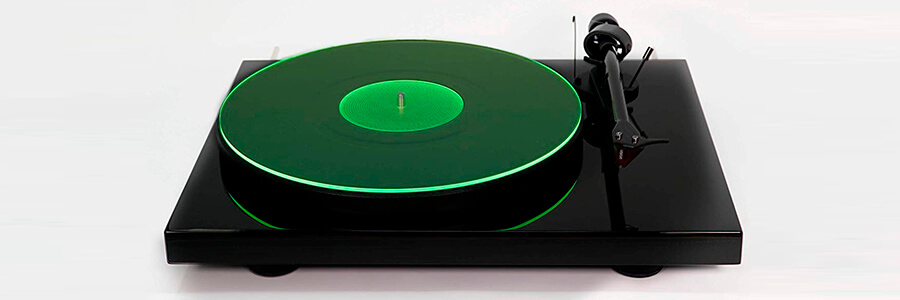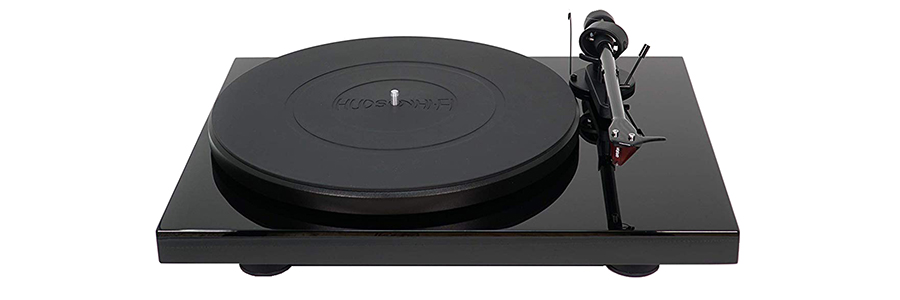While not all turntables require a mat, those that do require one know the importance of this detail. It not only protects your player and records from damaging but performs a lot more different functions. Especially if you are an experienced vinyl user and frequently invest in the purchase of some advanced accessories to update the overall setup.
It’s likely that you have observed the vast assortment of turntable mats available in the market. Until you try to choose it by yourself, you won’t know how hard this job is: Do you need a mat or a slipmat? It’s better to buy a classic rubber mat or to try something new? There are a lot of questions that may confuse even an experienced audiophile. When selecting a turntable mat, there are various factors to take into account, such as cost, durability, sound improvement, size, weight, thickness, and more.
The turntable mat reviews are aimed to help you with the right choice. We have condensed the main things that you need to know for making your purchase decision. To ensure that you have all the essential information regarding this topic, we recommend that you peruse our top picks and buyer’s guide.
Turntable Mats Reviews
Acrylic Turntable Mat | GreenLit | LP Slipmat

Choosing the best acrylic turntable mat, start with this option. This acrylic mat goes in a quite unusual design: a transparent disc of a clear green color lying on your turntable will definitely become one of the most noticeable things in the room. It goes with a protective removable film.
This turntable platter mat boasts a high density that ensures consistent speed, effectively minimizes vibrations, and delivers a more subdued sound without excessive splashing. It also dampens all background noises and mechanical sounds and provides tight bass. With its low static properties, the mat is designed to resist dust accumulation.
At a thickness of 3mm, this mat is considered a suitable choice for the majority of record players. The 5mm record label recess ensures your LPs to stay flat on the mat. In addition to its other features, this mat is also highly durable, making it suitable for repeated use.
Pros
- Suitable for standard 12-inch turntable platters.
- The mat is lightweight and moves freely on the platter.
- It can be additionally used to set arm bias (anti-skate force).
Cons
- Compared to other acrylic mats on the market, this one may be a bit pricey.
Hudson Hi-Fi Turntable Platter Mat

This mat from Hudson Hi-Fi is made from a silicone rubber. Due to this, it doesn’t have static and doesn’t attract dust to the unit. Additionally, it improves the sound quality of a record player and reduces the impact of vibrations. As a result, it all leads to improved sound reproduction.
The soft and smooth nature of this mat also provides protection for your records, eliminating the possibility of mechanical damage while playing.
This mat has a very affordable price. It also can be the best turntable mat in terms of versatility: it can be used for all standard turntables with 12 in platter size. Even despite the fact that this mat may seem too thick and heavy, it still fits for most turntables.
Pros
- This model will be good for noisy record players, as it reduces the mechanical noise.
- Protects the record from the slip.
- It has label recess, so the record stays flat on the mat.
Cons
- The rubber can flake over time.
- It starts smelling like a tire in the sun when the turntable heats up during operation.
Premium Leather Deer Hide Turntable Mat

This record mat from Jake’s Turntable Mats is of high-end quality and made from the deer hide. The use of deerskin material makes this mat an expensive option, as deerskin is typically twice as expensive as other types of leather. Nevertheless, this very kind of leather has a lot of pleasant qualities: it’s flexible, soft, and has less static in comparison with other leather mats. It has a standard 12-inch size, and it also can be custom-made accurately to the platter size.
This mat is capable of improving the quality of sound by softening it, as well as enhancing bass tones. There are also no crack and pop sounds at all when you use this mat. In addition to not attracting dust, this best turntable platter mat offers excellent protection for your records due to the softness of the deerskin material.
Pros
- It’s a double-sided mat — it can be used from both leather grain and suede sides.
- The use of animal skin in the production of this mat contributes to its durability.
- It cleans up very easily.
Cons
- This turntable mat may be too thin for some models.
CoRkErY Recessed Turntable Platter Mat

This mat is made from composite cork granule with a rubber mix. Compared to a plain cork mat, the use of animal skin in this mat makes it more durable and potentieally the best cork mat for turntable. This one can be a good option for replacing a felt mat. Despite its high durability, this mat is relatively affordable and outperforms felt mats in many aspects.
The present mat is soft enough to ensure the safety of vinyl records. This mat also resists dust accumulation and doesn’t pose difficulties when it comes to cleaning, as any dust particles can be easily brushed off. This mat improves grip on the records and drives through the needle. As a result, you will get a cleaner background, sharper image, better dynamic range, and tight bass. Plus, it avoids static load.
Despite the fact that it’s slightly smaller than a standard LP (11.375 in), the mat is still universal for all the turntables.
Pros
- The record label recess makes records stay flat on the mat.
- This mat damps resonances from metal turntable platters.
- This mat effectively reduces mechanical noise during playback.
Cons
- The CoRkErY may leave tiny bits of cork on the records.
Martelli Roundabout Set – 16″ Turntable, Cutting Mat

This product from Martelli Enterprises comes in a set with 3 items: turntable base, the cutting mat, and table-top ironing pad. It also has 30-piece ball bearings (it’s made from stainless steel) that ensure a smooth turn. It’s a self-healing mat which can be cleaned with water. This mat is highly versatile, as it was initially designed for quilters and can therefore be used for various other purposes. For example, you can use it for scrapbooking or crafting.
This potentially the best mat for turntable is available in various colors and patterns, allowing you to choose one that best suits your preferences.
Pros
- You can use the entire mat as a cutting surface.
- Easy to create and cut shapes.
Cons
- Compared to other options, this mat is one of the more expensive ones available.
- The mat isn’t suitable for standard 12-inch platters.
Fluance Turntable Platter Mat

This mat from Fluance is made of a rubber with silicone components and goes in classic black color. The manufacturer recommends pairing this mat with Fluance RT80/81, but, in fact, it’s compatible with all standard 12-inch turntable platters. This mat can be a great replacement for your felt mat for an affordable price. This mat is designed to protect against micro-vibrations, resulting in a clean and full sound picture.
Pros
- It has a scratch-free surface.
- The mat comes in a cardboard sleeve which protects it from bending.
Cons
- The mat doesn’t have noticeable protection from dust accumulation.
Electrohome Turntable Platter Mat

This record player mat is made of a durable black silicone rubber and is universal for all standard turntables. This solid rubber not only ensures reduced record slippage due to additional grip, but it is also not fragile at all so there is no need to be careful with it handling.
This mat provides reliable protection for both your turntable and records, safeguarding them against scratches. The mat helps your record player reproduce music as it meant to be: due to decent dampening qualities, the mat isolates the unit from unwanted vibrations resulting in deep and full sound reproduction. In addition to protecting against scratches, this mat also delivers a cleaner sound by reducing unwanted noise that can sometimes be present when using a felt mat, for example.
The recessed center makes a record lay flat on the surface despite label thickness. Using this mat during playback helps to maintain the integrity of the recording.
Pros
- This mat is so thin (2 mm only) that you can even use it on top of a stock mat to provide twice the dampening.
- It provides tightens sound, especially bass.
Cons
- It isn’t compatible with Electrohome record players.
Buyers Guide
What is a Turntable Mat and Why You May Need It?
A turntable mat is a removable cover for the platter on which you put the record. In other words, it’s an important cover between the records and the vinyl player. This mat is particularly necessary for turntables with metal or MDF platters, as it provides several important functions.
Due to its soft structure, the mat prevents mechanical damages on the platter. In addition, it protects the record from slipping of the platter thanks to a high coefficient of friction. In addition to its other functions, this mat also helps to prevent the accumulation of static electricity on the surface of the platter, which can lead to rapid dust pollution and characteristic crackles during playback.
The turntable mat also damps high-frequency vibrations (it includes bearing noise, motor noise, and cartridge feedback) and resonances directed to the platter and further to the pickup, disrupting its normal operation. This is connected with the vibrating stylus which causes resonances that will come back into the stylus if it’s not controlled. If so, this will blur the signal and will overlap the other parts to such an extent that they simply won’t be heard. A good mat can go a long way in resolving these issues.
The type of mat used can have a significant impact on the overall sound quality. A high-quality mat, like the ones mentioned above on our the best record player mat list, can ensure a smooth and even sound, improving bass performance, timing, and clarity in the midband.
Turntable Mats and Turntable Slipmats: How do They Differ?
A turntable mat can be easily confused with a slipmat, especially if you are a newbie. However, they have some significant differences that should be taken into account before you decide what exactly you need.
Slipmat
A slipmat is a round-shaped pad, often made from felt, necessary for DJs who use a vinyl player. IWhile slipmats can serve a similar purpose to turntable mats, they are not always the best option for a home record system. As they are primarily designed for DJing, they consider the possibility that a record can be scratched.
The best turntable slipmats create the desired degree of slip during manual rotation of the plate. Considering this fact, the slipmats prevent excessive displacement which can negatively affect the quality of work. A unique sound comes out when a DJ moves the vinyl record back and forth, but such manipulations are obviously harmful to a vinyl setup and a record itself. The use of a slipmat can prevent damage to vinyl and minimize wear and tear caused by the DJ’s actions.
So it turns out that it’s simply impossible to work on a vinyl player without a vinyl slipmat if you are a DJ, but it’s not what an average turntable owner needs at home.
Turntable mat
The best turntable mats do a great job in improving the sound reproduction of the turntable and protecting it from mechanical damages, slipping, static electricity, etc. It is worth to be noted that it’s more suitable for home turntables than a slipmat as you don’t have to overpay for some properties that are needed only for DJing.
Choosing the right type of mat can greatly enhance your listening experience.
Which Turntable Mat Material is Better for You?
Mats for vinyl players are made of various materials. Their characteristics and cost directly depend on which material they are made from. A mat can be made from felt, rubber, cork, leather, acrylic, and various other materials such as glass, for example. All materials have their own advantages and disadvantages, so the choice of which turntable mat to use depends on individual needs and budget constraints.
Felt
It’s the most popular material for stock mats. When purchasing a turntable, it usually comes with a felt mat which is also one of the least expensive mat materials. Most of the felt mats are soft and very thin with a thickness of only 2 mm. Despite the fact that a lot of turntable owners tend to replace a felt mat with a more advanced one. The felt mat gently treats the surface of records. Plus, they are quite universal and can be also used in DJing. However, they can attract dust and they are not easy to clean. Due to its softness, a felt matt isn’t durable, it’s very delicate and requires more careful handling than other types of mats.
Rubber
The rubber mats are also among the most popular ones. They isolate micro-vibrations, resulting in deep and full playback. Plus, they reliably keep the record in place due to its gripping properties, reduce dust, and are easy to clean. They also usually have a recessed center for the record to lay as flat as possible. Rubber turntable mats are known for their durability and flexibility, but they tend to be heavier than other materials, and can emit a strong odor. It also can be attached to the LPs.
Cork
The cork is light, airy, and non-stick. The turntable mats from cork effectively damp the resonances, keep the dust away from the platter, prevent slippage, and absorb vibrations. The aerated holes in such mat allow the turntable to project sound louder. The cork is highly recommended for steel and lightweight platters. They don’t cost very much, but they can be too thick for some players and may create static electricity.
Leather
Leather mats are typically made of soft suede leather with a thickness of 2-3 mm. Most of them have an elastic texture. It also has less static than other mats. The leather mats have all the necessary properties to improve the sound quality: they effectively damp the resonances and are usually bought by bass lovers, as they also can boost the overall beat. However, as all the natural materials, leather mats are obviously among the most costly.
Acrylic
Acrylic is a material that has similar characteristics to vinyl records, which allows it to reduce vibrations and provide clearer playback by improving the contact between the needle and the record. Plus, it makes the bass tighter and sharper. However, it’s expensive and doesn’t fit for some turntables.

Hi everyone! I’m Thomas Moody, also known as Guitarzan.

